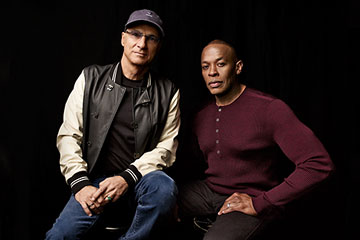
Rap's best-known producer masterminded the bass-heavy Beats sound.
(3 of 4)
By 2011, sales had surged to more than half a billion dollars annually. That year, Taiwanese cell-phone maker HTC put up $300 million to buy a 51% stake in Beats. The partnership, which seemed like an ideal way to match the headphones business with the fast-growing one for mobile devices, allowed Iovine and Dre to break away from Monster completely by the end of 2012 and set up their own manufacturing. But despite aggressive co-branding, the HTC partnership didn't yield any mega-hits. Last year, the duo bought back outstanding shares from HTC and raised a $500 million investment from the Carlyle Group, a private-equity giant. Dre and Iovine still own a controlling stake in the company.
Music Men
Today, the Beats offices in Santa Monica are just across Cloverfield Boulevard from Universal Music. This makes it easy for Iovine to commute from his "day job" as the chairman of Interscope Geffen A&M, a merged label that is now a division of Universal. The bright, modern offices are run by Luke Wood, a former alt-rock guitarist, music-biz PR man and Interscope executive who crossed the street permanently in 2011 to become Beats' chief operating officer.
Beats employs dozens of audio and electrical engineers, some of whom toil in a room filled with speakers and sound-dampening foam, measuring sound-wave curves while quickly switching between a Beats prototype and a competitor's models. Around the corner, designers think up new color schemes and patterns for upcoming limited-edition headphones. A green-and-yellow pair destined for the Brazilian soccer star Neymar has a verse from Deuteronomy inscribed above one of the earpieces. Deus não vos deixaré, nem vos desampararé, it reads--God will never abandon you, nor forsake you.
Beats customers will soon have one more painstakingly crafted product to consider, but if the company's headphones are made to be seen, the Beats Music service will only be heard. For the past decade, Reznor, who once recorded for Interscope, has been tinkering with the potential for technology and social media to expand his audience--new ways to sell music, market concert tickets and draw fans deeper into his world. Since taking the title of chief creative officer of Beats Music in 2013, Reznor has been the arbiter of whether the UX--user experience--is working, much the way Dre initially established the bass-heavy sound of Beats headphones.
The app, which will come preloaded on some AT&T phones, offers Mad Lib--style options for exploring the extensive music catalog, which is built on the bones of a previous service, MOG, that Beats reportedly bought for about $14 million in 2012. A listener can, for example, tell the app that he or she is "in the car" with "my boo" and looking to "pre-party" to "old skool dance." That particular combination of cues results in a playlist that includes Luscious Jackson's "Don't Look Back," Isaac Hayes' "Never Can Say Goodbye" and Prince's "When You Were Mine."
